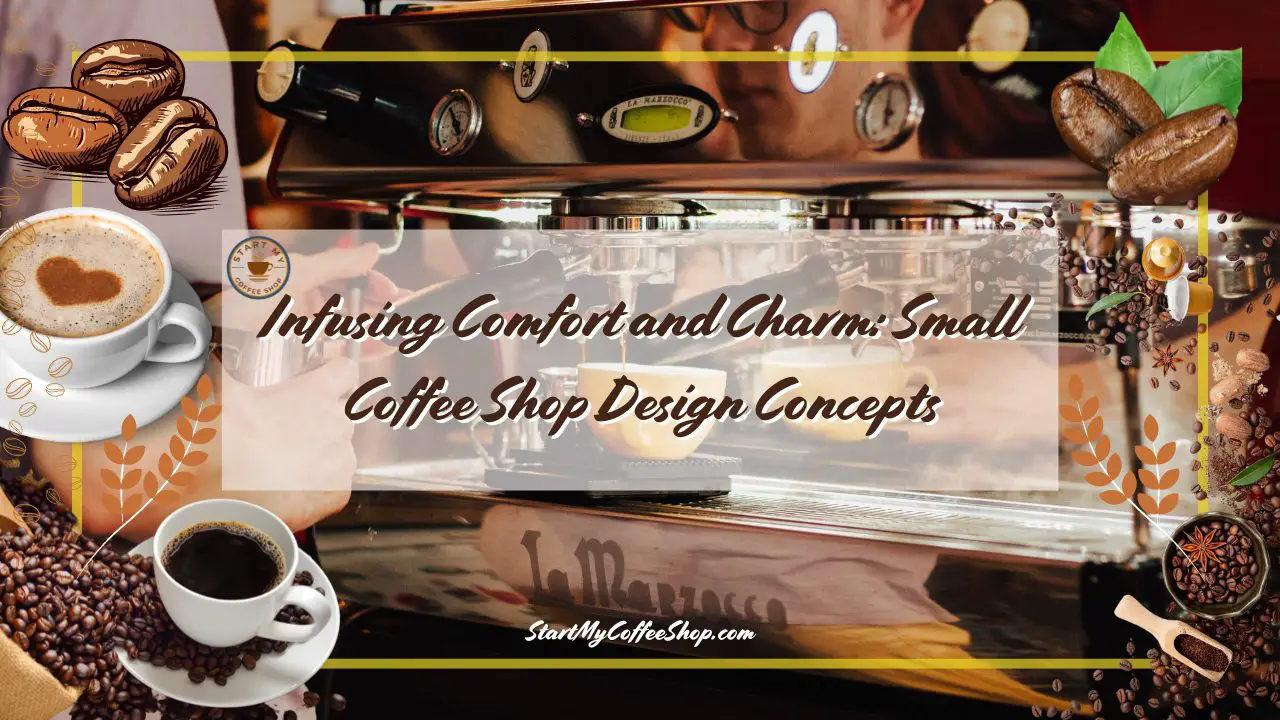A coffee shop is more than just a place to grab a cup of joe—it’s a sanctuary, a social hub, and a cozy retreat for many. The design of a coffee shop plays a crucial role in creating an atmosphere that entices customers to linger, fosters connections, and provides a respite from the outside world.
To design a coffee shop interior that’s warm and inviting while optimizing functionality and aesthetics, consider elements like comfortable seating, warm lighting, a cozy color palette, natural materials, efficient layout, and incorporating unique decor that reflects the coffee shop’s brand and personality.
In this article, I will delve into the art of effectively designing a coffee shop interior to strike the perfect balance between warmth, functionality, and aesthetics.
1. Understanding the Purpose
 Before embarking on the design journey, it is crucial to gain a deep understanding of the purpose and vision of your coffee shop. Determining whether your coffee shop aims to be a cozy corner for quiet conversations or a bustling meeting spot for professionals will guide your interior design choices.
Before embarking on the design journey, it is crucial to gain a deep understanding of the purpose and vision of your coffee shop. Determining whether your coffee shop aims to be a cozy corner for quiet conversations or a bustling meeting spot for professionals will guide your interior design choices.
By understanding your target audience and the desired ambiance, you can lay a solid foundation for the design process.
Consider the type of experience you want to create for your customers. Are you catering to a specific demographic, such as students, professionals, or families? Each group may have different preferences and expectations when it comes to the atmosphere of a coffee shop.
For instance, students may appreciate a vibrant and energetic environment with plenty of seating options for group study sessions, while professionals might prefer a more tranquil and focused space with designated areas for meetings.
By defining the purpose and vision, you can align your design decisions with the intended atmosphere. This understanding will guide choices regarding seating arrangements, lighting, color palette, materials, and decor elements.
It will also help you ensure that every aspect of the coffee shop’s interior design resonates with your target audience and creates an environment that fulfills their desires and expectations.
2. Creating a Welcoming Layout
 When designing the layout of a coffee shop, it is essential to prioritize both functionality and comfort. A well-designed layout should ensure smooth traffic flow while creating inviting spaces for customers to relax and socialize.
When designing the layout of a coffee shop, it is essential to prioritize both functionality and comfort. A well-designed layout should ensure smooth traffic flow while creating inviting spaces for customers to relax and socialize.
Consider incorporating a mix of seating options to cater to diverse preferences. Comfortable sofas and armchairs provide a cozy atmosphere, while bar stools are ideal for those seeking a more casual experience. By offering a variety of seating choices, you can accommodate different customer needs.
Strategic placement of tables is also crucial. Arrange them in a way that allows for intimate gatherings as well as individual workstations. Consider creating cozy nooks with comfortable seating for customers to enjoy quiet conversations. Additionally, leave enough room for customers to queue, order, and move around the coffee shop without feeling cramped or obstructed.
By thoughtfully designing the layout, you can optimize the functionality of the space while providing a welcoming environment that encourages customers to stay, socialize, and savor their coffee shop experience.
3. Harnessing the Power of Lighting
 Lighting is a critical element in crafting the desired mood and ambiance of a coffee shop interior. Choosing the right lighting can create a warm and inviting atmosphere that entices customers to stay and enjoy their time. Opt for warm, soft lighting that radiates a cozy glow throughout the space.
Lighting is a critical element in crafting the desired mood and ambiance of a coffee shop interior. Choosing the right lighting can create a warm and inviting atmosphere that entices customers to stay and enjoy their time. Opt for warm, soft lighting that radiates a cozy glow throughout the space.
Aim to strike a balance between natural and artificial lighting. During the daytime, harness the power of natural light by maximizing windows and skylights. This not only provides an inviting atmosphere but also allows customers to connect with the outside world. In the evenings, incorporate ambient, warm-toned artificial lighting that complements the cozy ambiance.
Dimmable lights are an excellent choice as they provide flexibility in adjusting the lighting intensity based on the time of day and desired atmosphere. Brighter lighting can create a more energetic and lively atmosphere, while softer, dimmed lighting promotes relaxation and intimacy.
Consider the placement of light fixtures to ensure even illumination throughout the coffee shop. Highlight specific areas such as seating zones, counter spaces, and artwork to create focal points and enhance visual interest.
4. Choosing a Harmonious Color Palette
Color selection is a crucial aspect of coffee shop interior design, as it has a profound impact on our emotions and perceptions. When choosing a color palette, consider the desired atmosphere and the emotions you wish to evoke in your customers.
Warm and earthy tones, such as browns, beiges, and soft yellows, create a sense of comfort, warmth, and relaxation. These hues can make customers feel at ease and encourage them to linger in your coffee shop.
Incorporating accents of vibrant colors like blues or greens can inject energy and visual interest into the space. These pops of color can stimulate creativity and add a refreshing touch to the ambiance.
It’s essential to consider the psychological effects of colors on customers. For example, warm colors like orange and red have been associated with increased appetite, making them suitable for coffee shops that offer baked goods or snacks.
Additionally, consider the cultural connotations and personal associations that different colors may have. Blue may convey a sense of calm and professionalism, while green can evoke nature and freshness.
Read more about Cost to Run a Small Coffee Shop: Setting the Budget for Your Coffee Shop
5. Embracing Natural Materials
Integrating natural materials into the interior design of your coffee shop adds a layer of warmth, authenticity, and visual appeal. Materials such as wood, stone, and brick create a sense of natural beauty and tactile richness. Consider incorporating these elements into various aspects of your coffee shop, such as furniture, flooring, accent walls, or even ceiling details.
Wood, with its unique grain patterns and warm hues, brings a sense of coziness and timelessness to the space. From wooden tables and chairs to reclaimed wood accents, incorporating this natural material can create a welcoming and rustic atmosphere.
Stone and brick, whether used as wall cladding or in architectural features, add texture and character. The ruggedness and earthy tones of these materials contribute to a sense of authenticity and charm. They can be particularly effective in creating focal points, such as a striking stone fireplace or an exposed brick wall.
6. Curating Unique Decor Elements
Decor is a key component in defining the character and identity of your coffee shop. It is an opportunity to infuse personality and create a welcoming ambiance that resonates with customers. When selecting decor elements, consider choosing items that reflect your coffee shop’s brand and values.
Vintage posters, quirky signs, or local artwork can add charm and uniqueness to the space. These elements can serve as conversation starters and contribute to the overall atmosphere. Carefully chosen artwork can create a sense of visual interest and engagement.
Integrating live plants into your coffee shop not only adds a touch of freshness but also enhances the ambiance by bringing nature indoors. Plants have a calming effect and contribute to a sense of tranquility, making them perfect for creating a relaxing environment where customers can unwind and enjoy their coffee.
When incorporating decor, it is crucial to strike a balance between functionality and aesthetics. Avoid clutter by carefully curating and arranging decorative items. Opt for a clean aesthetic that allows the decor elements to shine without overwhelming the space.
7. Comfortable Seating for All
Seating holds a fundamental role in creating a welcoming and comfortable atmosphere within a coffee shop. It is crucial to prioritize comfort when selecting seating options. Opt for ergonomic chairs that provide proper support for prolonged sitting. Incorporate plush cushions and soft upholstery to enhance the overall coziness of the seating.
To cater to different preferences and group sizes, it’s important to offer a variety of seating options. Communal tables provide a space for group gatherings or shared work sessions, fostering a sense of community.
Individual armchairs and cozy sofas cater to solo visitors seeking a moment of relaxation or focused work. Intimate corners with comfortable seating arrangements create a cozy ambiance for private conversations or quiet reading.
Recognizing the needs of modern customers, it is essential to provide ample power outlets and charging stations throughout the coffee shop. This ensures that individuals can work, study, or simply stay connected while enjoying their coffee.
8. Optimizing Space and Functionality
Efficient space utilization is essential in optimizing functionality within a coffee shop. The layout should facilitate seamless movement and accessibility to various areas, including the counter, seating, and restrooms. Take into account the workflow of the baristas and design the space accordingly, minimizing congestion and ensuring smooth operations.
To maintain an organized environment, incorporate storage solutions that keep supplies and equipment easily accessible, reducing clutter and enhancing efficiency. By strategically designing the layout with a focus on easy navigation, streamlined operations, and effective storage, you create a coffee shop that maximizes functionality and provides a seamless experience for both customers and staff.
9. Attention to Acoustics
Creating the right noise level is crucial for the ambiance of a coffee shop. Striking a balance between a lively atmosphere and a comfortable noise level can be achieved by incorporating sound-absorbing materials.
Consider using acoustic panels, carpeting, or curtains to minimize echoes and reverberation, effectively reducing overall noise levels. These materials help create a more intimate and pleasant auditory experience for customers.
Additionally, soft background music can contribute to the ambiance without overpowering conversations, adding a soothing layer to the overall atmosphere. By carefully managing noise levels through sound-absorbing materials and background music, you can create a coffee shop environment where customers can enjoy their conversations, relax, and savor the moment.
Read more about Cost to Start Coffee Shop Business: The Unfiltered Finances
10. Engaging the Senses
To elevate the customer experience, it’s important to engage their senses beyond visual aesthetics. The aroma of freshly brewed coffee is a fundamental aspect of any coffee shop. Invest in high-quality coffee beans and ensure proper ventilation to allow the enticing scent to permeate the space, instantly enveloping customers in a warm and inviting atmosphere.
Carefully selected background music can also contribute to the overall sensory experience. Choose music that matches the ambiance you want to create, whether it’s soothing tunes for relaxation or upbeat melodies for a vibrant atmosphere. The right auditory backdrop can enhance the overall mood and make customers feel more immersed in the coffee shop experience.
Consider going beyond coffee by offering delicious baked goods or other treats. The taste and aroma of freshly baked pastries or snacks can further stimulate customers’ senses and create a memorable experience. By catering to their sense of taste, you add another layer of enjoyment to their visit.
Summary
Designing the interior of a coffee shop is a creative endeavor that requires careful consideration of various elements. By focusing on creating a warm and inviting atmosphere while optimizing functionality and aesthetics, coffee shop owners and designers can curate spaces that captivate customers and keep them coming back.
Through thoughtful choices in seating, lighting, color palette, materials, layout, and unique decor, a coffee shop can become a haven where people gather, connect, and savor the sensory delights it offers. Embrace the art of coffee shop design, and let your space reflect the heart and soul of your establishment.
Frequently Asked Questions
Q: How can I choose the right seating arrangement for my coffee shop?
A: When selecting seating options, consider the target audience and the desired atmosphere of your coffee shop.
Q: What lighting is best suited for creating a warm and inviting ambiance?
A: To achieve a cozy atmosphere, opt for warm, soft lighting. Incorporate a mix of natural light during the day and warm-toned artificial lighting in the evenings.
Q: What are some tips for optimizing space and functionality in a coffee shop?
A: Efficient space utilization is key. Design the layout to allow for easy movement and access to different areas.
To learn more on how to start your own coffee shop checkout my startup documents here
Please note: This blog post is for educational purposes only and does not constitute legal advice. Please consult a legal expert to address your specific needs.

Hi! I’m Shawn Chun
My adventure in coffee began when I first launched my first coffee shop back in the early 2000s. I had to figure out so many things on my own and to make it worse within 2 years of opening two large corporate coffee chains moved in just blocks away from me!
As I saw smaller and even some larger coffee shops in the neighborhood slowly lose customers to these giant coffee chains and slowly close up shop, I knew that I had to start getting creative…or go out of business.
I (like you may be) knew the coffee industry well. I could make the best latte art around and the foam on my caps was the fluffiest you have ever seen. I even had the best state-of-the-art 2 group digital Nuova Simonelli machine money could buy. But I knew that these things alone would not be enough to lure customers away from the name brand established coffee shops.
Eventually, through lots of trial and error as well as perseverance and creativity I did find a way to not only survive but also thrive in the coffee/espresso industry even while those corporate coffee chains stayed put. During those years I learned to adapt and always faced new challenges. It was not always easy, however, in the end, I was the sole survivor independent coffee shop within a 10-mile radius of my location. Just two corporate coffee chains and I were left after that year. All told the corporate coffee chains took down over 15 small independent coffee shops and kiosks and I was the last one standing and thriving.
Along the years I meet others with the same passion for coffee and I quickly learned that it is not only “how good a barista is” that makes a coffee shop successful, but the business side of coffee as well.
Hence why I started this website you are on now. To provide the tools and resources for up and coming coffee shop owners to gain that vital insight and knowledge on how to start a coffee shop successfully.
Stick around, browse through my helpful blog and resources and enjoy your stay! With lots of LATTE LOVE!
Shawn






